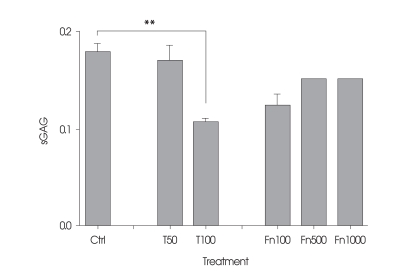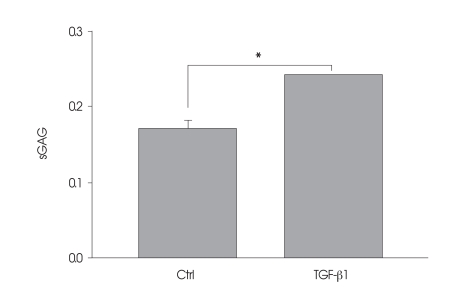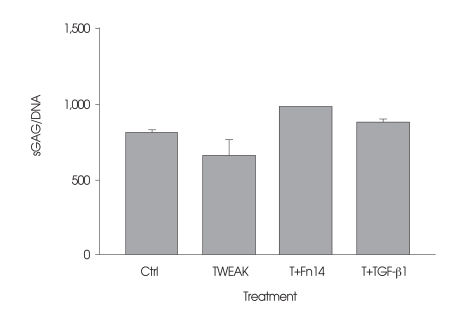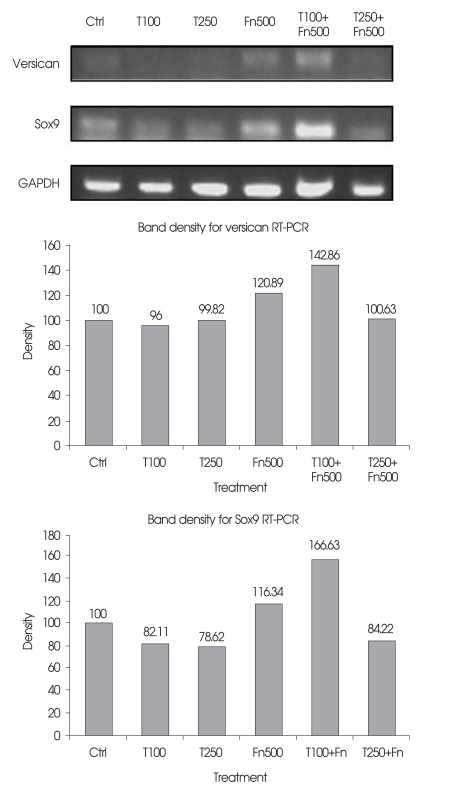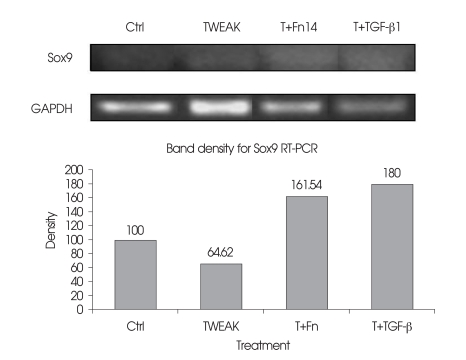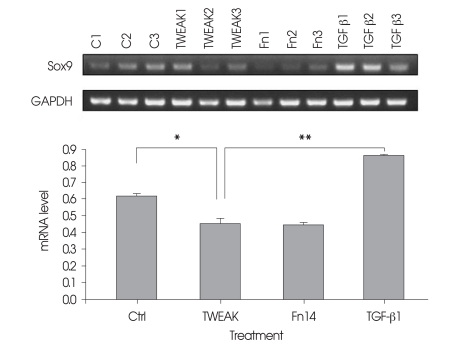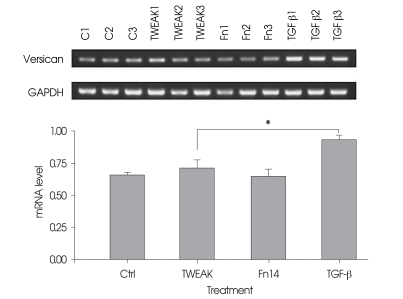Abstract
Objective
The purpose of this study is to explain the effect and reciprocal action among tumor necrosis factor (TNF) like weak inducer of apoptosis (TWEAK), fibroblast growth factor-inducible 14 (Fn14), and transforming growth factor-β1 (TGF-β1) on degeneration of human intervertebral disc (IVD).
Methods
Human intervertebral disc tissues and cells were cultured with Dulbecco's Modified Eagle's Medium/Nutrient F-12 Ham (DMEM/F-12) media in 37℃, 5% CO2 incubator. When IVD tissues were cultured with TWEAK, Fn14 that is an antagonistic receptor for TWEAK and TGF-β1, the level of sulfated glycosaminoglycan (sGAG) was estimated by dimethyl methyleneblue (DMMB) assay and sex determining region Y (SRY)-box 9 (Sox9) and versican messenger ribonucleic acid (mRNA) levels were estimated by reverse transcriptase polymerase chain reaction (RT-PCR).
Results
When human IVD tissue was cultured for nine days, the sGAG content was elevated in proportion to culture duration. The sGAG was decreased significantly by TWEAK 100 ng/mL, however, Fn14 500 ng/mL did not change the sGAG production of IVD tissue. The Fn14 increased versican and Sox9 mRNA levels decreased with TWEAK in IVD tissue TGF-β1 20 ng/mL elevated the sGAG concentration 40% more than control. The sGAG amount decreased with TWEAK was increased with Fn14 or TGF-β1 but the result was insignificant statistically. TGF-β1 increased the Sox9 mRNA expression to 180% compared to control group in IVD tissue. Sox9 and versican mRNA levels decreased by TWEAK were increased with TGF-β1 in primary cultured IVD cells, however, Fn14 did not show increasing effect on Sox9 and versican.
Conclusion
This study suggests that TWEAK would act a role in intervertebral disc degeneration through decreasing sGAG and the mRNA level of versican and Sox9.
Keywords: Intervertebral disc, TWEAK, Fn14, TGF-β1, Sox9, Versican
INTRODUCTION
Lumbar disc degeneration is a common problem that is a leading cause of low back pain in humans. It has been widely held that symptoms of lumbar disc disease are the result of either herniation of the nucleus pulposus through a mechanically weak annulus fibrosis or from tearing of the annulus itself15). The normal intervertebral discs have three components : end plate, nucleus pulposus and annulus fibrosus. The end plate is formed from cartilage that resembles articular cartilage and vertebral cortex. The nucleus pulposus consists of chondrocytes within a matrix of type II collagen and proteoglycan and annulus fibrosus comprises dense sheet of highly orientated type I collagen fibers containing fibroblast-like cells10). Disc degeneration accompany with several phenomena such as decreased aggrecan and type II collagen productions, or elevated type I collagen synthesis and type II collagen denaturation13).
Tumor necrosis factor (TNF) like weak inducer of apoptosis (TWEAK) is a member of the TNF superfamily originally identified as a weak inducer of apoptosis in certain tumor cell lines2). As with other members of the TNF superfamily TWEAK has pleiotropic effects including proangiogenic effects on vascular endothelial cells, proinflammatory activities on epithelial and endothelial cells, as well as proliferation enhancing effects on endothelial cells and astrocytes17).
TWEAK receptor named fibroblast growth factor-inducible 14 (Fn14) is a member of the TNF receptor superfamily that expressed by nonlymphoid cell types. TWEAK/Fn14 interaction plays important roles in proliferation, migration, inflammatory responses, and survival in a variety of cell types, including endothelial, epithelial, immune and some tumor cells1).
Transforming growth factor-β1 (TGF-β1) is known to modulate cell differentiation, bone formation, angiogenesis, hematopoiesis, cell cycle progression, cellular migration and extracellular matrix production and especially involved in proteoglycan synthesis in intervertebral disc cells16). TGF-β1 treatment increased mitogen-activated protein kinases (MAPK) activity and sex determining region Y (SRY)-box 9 (Sox9), aggrecan, and collagen type II gene expression19). Sox9, a transcription factor, belongs to the SRY (sex-determining region on the Y chromosome) family and plays a role in chondrogenesis and type II collagen expression7). The loss of expression of Sox9 in some of the annulus cell population may play a role in disc aging and degeneration, possibly by decreased modulation of the expression and production of type II collagen by disc cells5).
In current study, the change of sulfated glycosaminoglycan (sGAG) amount was examined in various culture conditions or after treatment of TWEAK, its receptor Fn14 and TGF-β1. The messenger ribonucleic acid (mRNA) levels of Sox9 and versican were estimated in cells treated with TWEAK, Fn14 and TGF-β1.
MATERIALS AND METHODS
Materials
Human intervertebral disc tissue specimens were granted from hospitals in Seoul. These tissue samples were obtained from fifteen patients and stored in DMEM-F12 media (Jeil Biotechservices Inc., Seoul, Korea) containing 10% fetal bovine serum (Jeil Biotechservices) and 1% antibiotic-antimycotic solution (Jeil Biotechservices) in the entire study period, and the sample of 5-8 gram obtained from one or two patients was used in one experiment.
Human intervertebral disc primary cell and tissue culture
Human intervertebral disc tissues were minced by surgical blade and pincette in DMEM-F12 media. And disc tissue culture was incubated in 37℃, 5% CO2 incubator. Minced disc tissue was sequentially digested with 0.2% pronase and 0.025% collagenase (SIGMA-ALDRICH., St. Louis, MO, USA) in DMEM/F-12 media. Separated cell solution was centrifuged at 1,200 rpm, for 5 min, and precipitated cells were resuspended in media. Resuspended cell solution was poured to 100 mm culture dish and incubated in 37℃, 5% CO2 incubator. The minced intervertebral disc tissue was incubated with DMEM-F12 media containing 10% fetal bovine serum and 1% antibiotic-antimycotic solution in 37℃, 5% CO2 incubator.
Dimethylmethylene blue assay for glycosaminoglycan quantification
The amount of sulfated sGAG in the culture media was determined by invoking Ferndale's method4). DMMB assay reagent solution (16 mg DMMB in 1 L distilled water containing 2.37 g NaCl, 3.04 g glycine, 95 mL HCl) (SIGMA-ALDRICH) was prepared and stored at room temperature. The amount of sGAG in the samples was estimated via method that 900 mL DMMB solution was added to a 100 mL sample media in a 1.5 mL tube and mixed and then transferred to cuvette. The rate of absorbance was immediately read at 525 nm. The assay was calibrated by use of reagent blanks and standards containing up to 1.8 ug/mLof chondroitin sulfate (SIGMA-ALDRICH).
Reverse transcription polymerase cnain reaction for the estimation of Sox9 and versican mRNA levels
Total RNA was extracted by the TriZol reagent (Invitrogen., Carlsbad, CA, USA) according to manual. Complementary DNA was synthesized by SuperScript III (Invitrogen) reverse transcriptase from total RNA, and polymerase chain reactions (PCR) for Sox9 and versican were administered with PCR PreMix kit (iNtRON Biotechnology., Gyeonggi, Korea). The primer sequences used for RT-PCR are as follows : Sox9 forward primer; 5'-TTTCCAAGACACAAACATGA-3', Sox9 reward primer; 5'-AAAGTCCAGTTTCTCGTTGA-3', versican forward primer; 5'-CTGCCCCGAGCCTTTCT-3', versican reward primer; 5'-GCGGCTTATTGCAGTTTGG-3'.
Statistical analysis
Data are presented as mean ± SEM (Standard Error of Measures). Statistically significant differences between two groups were calculated by the Student's t-test and one-way ANOVA was used to certify the statistical differences among over three groups. A value of p < 0.05 was considered significant.
RESULTS
The production amount of sGAG in cultured intervertebral disc tissue during culture duration
To investigate the change of sGAG production amount during culture duration, intervertebral disc tissue was cultured for 9 days. After 2, 4, 6 or 9 days cultivation, the sGAG was gradually increased with culture duration, and it was especially the largest on ninth day after culture initiation (Fig. 1). The sGAG production was more increased to 21% at ninth day after culture compared to second day in culture system (p < 0.05).
Fig. 1.
The relation of sulfated glycosaminoglycan (sGAG) production amount with culture duration in intervertebral disc culture. The sGAG was gradually increased with culture duration, and it was the largest on nine day after culture initiation (*p < 0.05 ).
The change of sGAG in the condition of TWEAK or Fn14 treatment
In order to speculate the effect of TWEAK and Fn14 on sGAG production in intervertebral disc tissue culture, we treated TWEAK of various concentration (50-100 ng/mL) and Fn14 (100-1000 ng/mL) to cultured intervertebral disc tissues during three days. The production amount of sGAG in TWEAK 100 ng/mL treated group was decreased more than control group (p < 0.005). But, in disc cultures treated with TWEAK inhibitor (Fn14) of various concentration (100, 500 and 1,000 ng/mL), sGAG production was not changed compared to control group (Fig. 2).
Fig. 2.
The change of sGAG by TWEAK or Fn14 in intervertebral disc culture. TWEAK 100 ng/mL decreased the sGAG compared to control group, but TWEAK inhibitor, Fn14 500 ng/mL did not have an effect to sGAG production (**p < 0.005).
The effect of TGF-β1 on sGAG production in intervertebral disc culture
TGF-β1 20 ng/mL increased sGAG concentration to 40.8% compared to control group (p < 0.05) (Fig.3).
Fig. 3.
The increase of sGAG production rate with TGF-β1. TGF-β1 20 ng/mL increased more sGAG concentration than control group (*p < 0.05).
The change of sGAG production amount in intervertebral disc tissue culture treated with TWEAK, Fn14 and TGF-β1
TGF-β1 and Fn14 showed a tendency that sGAG amount decreased with TWEAK was increased through the treatment of Fn14 or TGF-β1 but the result was insignificant (Fig. 4).
Fig. 4.
Sulfated glycosaminoglycan (sGAG) production rate in intervertebral disc tissue treated with TWEAK, Fn14, and TGF-β1. TGF-β1 and Fn14 showed a tendency that sGAG amount decreased with TWEAK was increased through the treatment of Fn14 or TGF-β1.
The mRNA expression levels of versican and Sox9 in intervertebral disc tissue treated with TWEAK and Fn14
In order to examine the expression rates of versican and Sox9 mRNA in intervertebral disc tissue treated with TWEAK and Fn14, we treated the TWEAK of serial concentrations (100-250 ng/mL), Fn14 500 ng/mL. And, we studied the co-treated effect of TWEAK and Fn14 on mRNA expression levels of versican and Sox9. In TWEAK 100 ng/mL treated condition, the mRNA levels of versican and Sox9 genes were reduced to 95% and 82% in each, also they were decreased to 99% and 78%, respectively, in the condition of 250 ng/mL TWEAK treatment. The mRNA expression rates of versican and Sox9 were more increased 120% and 116%, respectively, than control group in Fn14 500 ng/mL treated condition.
In the co-treated condition of TWEAK 100 ng/mL and Fn14 500 ng/mL, versican and Sox9 mRNA levels were significantly increased to 142% and 156% in each. But, Fn14 did not increase the mRNA levels in TWEAK 250 ng/mL treated condition. The increasing capability of Fn14 was prominent in the condition of co-treatment with TWEAK 100 ng/mL (Fig. 5). TGF-β1 20 ng/mL increased the Sox9 mRNA expression to 180% in co-treated condition with TWEAK 100 ng/mL compared to control group. Both Fn14 and TGF-β1 increased the mRNA expression of Sox9 decreased by TWEAK (Fig. 6).
Fig. 5.
The mRNA levels of versican and Sox9 in cultured intervertebral disc with treatment of TWEAK and Fn14. The expression rates of versican and Sox9 decreased by TWEAK were increased through Fn14 treatment. The increasing capability of Fn14 was prominent in the condition of co-treatment with TWEAK 100 ng/mL.
Fig. 6.
Sox9 mRNA level in intervertebral disc culture in the condition of TWEAK, Fn14, and TGF-β1 treatment. Both Fn14 and TGF-β1 increased the mRNA expression of Sox9 decreased by TWEAK.
The mRNA level of Sox9 and versican in primary cultured intervertebral disc cells treated with TWEAK, Fn14 and TGF-β1
Sox9 mRNA expression was decreased with TWEAK, however, it was more increased with TGF-β1 treatment than only TWEAK treated group in primary cultured intervertebral disc cells (Fig. 7). But, Fn14 did not show increasing effect on Sox9 mRNA expression rate. Versican mRNA expression was elevated more with TGF-β1 treatment than only TWEAK treated group (Fig. 8).
Fig. 7.
Sox9 mRNA level in primary cultured intervertebral disc cells treated by TWEAK, Fn, and TGF-β1. Sox9 mRNA expression was decreased with TWEAK and more increased with TGF-β1 than only TWEAK treated group (*p < 0.05, **p < 0.005).
Fig. 8.
Versican mRNA level in primary cultured intervertebral disc cells treated by TWEAK, Fn, and TGF-β1. Versican mRNA expression was increased more with TGF-β than only TWEAK treated group (*p < 0.05).
DISCUSSION
Herniation of spinal discs (HD) is a common problem that is responsible for symptoms in up to 40% of all patients with low back pain3). Although the primary cause of low back pain has not been identified, disc degeneration seems to be related to the intensity of low back pain due to loss of mechanical stability in the spine.
TWEAK stopped endogenous repair by blocking differentiation of osteoblastic and chondrocytic precursors17). In disc tissues, TWEAK plays a role in matrix metalloproteinases (MMP)-3 upregulation and aggrecan downregulation, resulting in proteoglycan degradation and promotion of disc degeneration21).
The degeneration of the intervertebral disc is related to a variety of inflammatory mediators including nitric oxide (NO), interleukins, MMP, prostaglandin E2 (PGE2), tumor necrosis factor (TNF) alpha and other cytokines18).
It was reported that MMP-3 and MMP-7 play crucial roles in IVD degradation of in vitro murine culture model of the acute HD6). TNF-alpha and interleukin (IL)-1beta both caused an increase in protease transcription [MMP-3, MMP-13, a disintegrin and matrix metalloproteinase with thrombospondin motif (ADAMTS) 4 and ADAMTS5] and in pro-inflammatory enzymes, inducible nitric oxide synthase and cyclooxygenase (COS)-2, as well as a decrease in matrix protein transcription, including collagen II, aggrecan, fibromodulin and link protein (IL-1 beta only), and an increase in MMP-3 and MMP-9 secretion20).
The positive immunofluorescence stained cell numbers for aggrecan, type I-II collagen, bone morphogenetic protein (BMP)-2 and BMP-7 (members of TGF-β family) were also increased after each TGF-β1 and recombinant human BMP-2 treatment, and also more increased significantly in the aggrecan, type I, II collagen, BMP-2 and 7 when they were used jointly8).
Among IL-1 inhibitors, IL-1 receptor antagonist (IL-1ra) might be a candidate for preventing IVD degeneration12). Indeed, Le Maitre and colleagues9) have shown in monolayer and three-dimensional alginate-cultured resident cells from degenerate IVDs that IL-1ra down-regulates metal-dependent proteases and, delivered directly or by gene therapy in explants of degenerated human IVDs, almost completely eliminates enzyme activity, thereby decreasing extracellular matrix degradation11).
BMP-2 significantly increased aggrecan and collagen type II mRNA expression 8.3 and 4.61 times, respectively, and decreased versican mRNA expression 0.54 times as compared with control. BMP-2 significantly increased TGF-β1 and BMP-7 mRNA expression 2.32 and 2.45 times, respectively, compared with control. There was no significant change in BMP-6 mRNA expression14).
In this study, TWEAK 100 ng/mL decreased the mRNA expression levels of Sox9 and versican, however, those were more increased with Fn14 500 ng/mL than control in intervertebral disc tissue culture. The TWEAK decreased sGAG production, but Fn14 and TGF-β1 increased it above normal level. Transforming growth factor-β1 increased sGAG production and elevated Sox9 mRNA level decreased by TWEAK more than Fn14 in intervertebral disc tissue culture. In other report, TWEAK induced disc degeneration via the elevation of MMP-3 expression, and Fn14 antagonized the effect of TWEAK21). Our study confirmed the reciprocal reaction of TWEAK and Fn14 on disc degeneration and had a meaning showed an interrelation between TWEAK, Sox9, versican and TGF-β1. It was suggested that TWEAK has a negative effect on sGAG production via lowering the mRNA expression of Sox9 and versican participated in the production of sGAG and other proteoglycan in nucleus pulposus from our results. In intervertebral disc cell culture TWEAK decreased the mRNA level of only Sox9, however, Fn14 didn't have an effect to the decreased condition by TWEAK. But TGF-β1 elevated the mRNA expression of both Sox9 and versican more than only TWEAK treated group. It was postulated that TGF-β1 has a stronger effect on TWEAK than Fn14.
CONCLUSION
This study suggests that TWEAK would play a role in intervertebral disc degeneration through decreasing sulfate glycosaminoglycan (sGAG) and mRNA expression levels of versican and Sox9, and the negative effect of TWEAK on intervertebral disc integrity should be reversed with Fn14 and TGF-β1.
It is supposed that the antagonistic relation of TWEAK and TGF-β1, or Fn14 has an important role on intervertebral disc homeostasis.
References
- 1.Ando T, Ichikawa J, Wako M, Hatsushika K, Watanabe Y, Sakuma M, et al. TWEAK/Fn14 interaction regulated RANTES production, BMP-2-induced differentiation, and RANKL expression in mouse osteoblastic MC3T3-E1 cells. Arthritis Res Ther. 2006;8:R146. doi: 10.1186/ar2038. [DOI] [PMC free article] [PubMed] [Google Scholar]
- 2.Chicheportiche Y, Bourdon PR, Xu H, Hsu YM, Scott H, Hession C, et al. TWEAK, a new scereted ligand in the tumor necrosis factor family that weakly induces apoptosis. J Biol Chem. 1997;272:32401–32410. doi: 10.1074/jbc.272.51.32401. [DOI] [PubMed] [Google Scholar]
- 3.Deyo RA. Back surgery-who needs it? N Engl J Med. 2007;356:2239–2243. doi: 10.1056/NEJMp078052. [DOI] [PubMed] [Google Scholar]
- 4.Farndale RW, Buttle DJ, Barrett AJ. Improved quantitation and discrimination of sulphated glycosaminoglycans by use of dimethylmethylene blue. Biochim Biophys Acta. 1986;883:173–177. doi: 10.1016/0304-4165(86)90306-5. [DOI] [PubMed] [Google Scholar]
- 5.Gruber HE, Norton HJ, Ingram JA, Hanley EN., Jr The Sox9 transcription factor in the human disc : decreased immunolocalization with age and disc degeneration. Spine. 2005;30:625–630. doi: 10.1097/01.brs.0000155420.01444.c6. [DOI] [PubMed] [Google Scholar]
- 6.Haro H, Crawford HC, Fingleton B, MacDougall JR, Shinomiya K, Spengler DM, et al. Matrix metalloproteinase-3-dependent generation of a macrophage chemoattractant in a model of herniated disc resorption. J Clin Invest. 2000;105:133–141. doi: 10.1172/JCI7090. [DOI] [PMC free article] [PubMed] [Google Scholar]
- 7.Kwawakami Y, Rodriguez-Leon J, Belmonte JC. The role of TGF-βs and Sox9 during limb chondrogenesis. Curr Opin Cell Bio. 2006;18:723–729. doi: 10.1016/j.ceb.2006.10.007. [DOI] [PubMed] [Google Scholar]
- 8.Kuh SU, Zhu Y, Li J, Tsai KJ, Fei Q, Hutton WC, et al. Can TGF-β1 and rhBMP-2 act in synergy to transform bone marrow stem cells to discogenic-type cells? Acta Neurochir (Wien) 2008;150:1073–1079. doi: 10.1007/s00701-008-0029-z. discussion 1079. [DOI] [PubMed] [Google Scholar]
- 9.Le Maitre CL, Freemont AJ, Hoyland JA. A preliminary in vitro study into the use of IL-1Ra gene therapy for the inhibition of intervertebral disc degeneration. Int J Exp Pathol. 2006;87:17–28. doi: 10.1111/j.0959-9673.2006.00449.x. [DOI] [PMC free article] [PubMed] [Google Scholar]
- 10.Le Maitre CL, Hoyland JA, Freemont AJ. Degeneration of intervertebral discs : current understanding of cellular and molecular events, and implications for novel therapies. Expert Rev Mol Med. 2001;29:1–10. doi: 10.1017/S1462399401002885. [DOI] [PubMed] [Google Scholar]
- 11.Le Maitre CL, Hoyland JA, Freemont AJ. Interleukin-1 receptor antagonist delivered directly and by gene therapy inhibits matrix degradation in the intact degenerate human intervertebral disc : an in situ-zymographic and gene therapy study. Arthritis Res Ther. 2007;9:R83. doi: 10.1186/ar2282. [DOI] [PMC free article] [PubMed] [Google Scholar]
- 12.Le Maitre CL, Hoyland JA, Freemont AJ. The role of interleukin-1 in the pathogenesis of human intervertebral disc degeneration. Arthritis Res Ther. 2005;7:R732–R745. doi: 10.1186/ar1732. [DOI] [PMC free article] [PubMed] [Google Scholar]
- 13.Lee YJ, Kong MH, Song KY, Lee KH, Heo SH. The relation between SOX 9, TGF β1 and proteoglycan in human intervertebral disc cells. J Korean Neurosurg Soc. 2008;43:149–154. doi: 10.3340/jkns.2008.43.3.149. [DOI] [PMC free article] [PubMed] [Google Scholar]
- 14.Li J, Yoon ST, Hutton WC. Effect of bone morphogenetic protein-2(BMP-2) on matrix production, other BMPs, and BMP receptors in rat intervertebral disc cells. J Spinal Disord Tech. 2004;17:423–428. doi: 10.1097/01.bsd.0000112084.85112.5d. [DOI] [PubMed] [Google Scholar]
- 15.Martin MD, Boxell M, Malone DG. Pathophysiology of lumbar disc degeneration : a review of the literature. Neurosurg Focus. 2002;13:E1. doi: 10.3171/foc.2002.13.2.2. [DOI] [PubMed] [Google Scholar]
- 16.Okargly A, Balwit JM, Haak-Frendscho M. Transforming Growth Factor beta-1: (TGF-beta-1)a biological paradox. Promega Notes. 1994;47:10. [Google Scholar]
- 17.Perper SJ, Browning B, Burkly LC, Weng S, Gao C, Giza K, et al. TWEAK is a novel arthritogenic mediator. J Immunol. 2006;177:2610–2620. doi: 10.4049/jimmunol.177.4.2610. [DOI] [PubMed] [Google Scholar]
- 18.Podichetty VK. The aging spine : the role of inflammatory mediators in intervertebral disc degeneration. Cell Mol Biol. 2007;53:4–18. [PubMed] [Google Scholar]
- 19.Risbud MV, Albert TJ, Guttapalli A, Vresilovic EJ, Hillibrand AS, Vaccaro Ar, et al. Differentiation of Mesenchymal Stem Cells towards a nucleus pulposus-like phenotype in vitro : implications for cell based transplantation therapy. Spine. 2004;29:2627–2632. doi: 10.1097/01.brs.0000146462.92171.7f. [DOI] [PubMed] [Google Scholar]
- 20.Stevens AL, Wheeler CA, Tannenbaum SR, Grodzinsky AJ. Nitric oxide enhances aggrecan degradation by aggrecanase in response to TNF-alpha but not IL-1beta treatment at a post-transcriptional level in bovine cartilage explants. Osteoarthritis Cartilage. 2008;16:489–497. doi: 10.1016/j.joca.2007.07.015. [DOI] [PMC free article] [PubMed] [Google Scholar]
- 21.Wako M, Haro H, Ando T, Hatsushika K, Ohba T, Iwabuchi S, et al. Novel function of TWEAK in inducing intervertebral disc degeneration. J Orthop Res. 2007;25:1438–1446. doi: 10.1002/jor.20445. [DOI] [PubMed] [Google Scholar]




